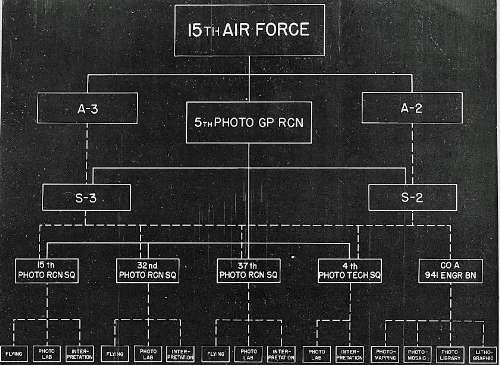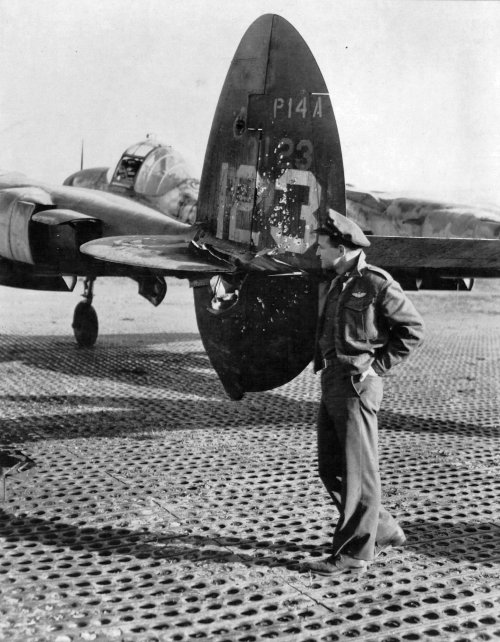5th Photo Recon Group
The 5th Photo Recon Group consisted of the following organizations:
| 15th Photo Recon Squadron | 32nd Photo Recon Squadron | 37th Photo Recon Squadron | 4th Photo Tech squadron |
The 5th Reconnaissance Group was assigned to the Fifteenth Air Force on l October 1944. With this assignment the Air Force acquired the intelligence procuring end producing unit essential to the completion of its organization.
Courtesy of Gerry Kersey
Col. Leon W. Gray. At this time, he was a Major. He was CO of the 5th Photo Reconnaissance Group, which he led in North Africa (La Marsa, Tunisia) and Italy (San Severo) from October 1942 to February 1944. This aircraft, F-5A-10 #42-13123, was lost in action on September 11, 1944, when Lt. Col. James F. Setchell of HQ, 90th Photo Wing (the 5th Photo Reconnaissance Group was attached to this Wing) ditched the aircraft off the coast of Greece near Athens during a low-altitude photo mission (which he survived).
History
The 5th Reconnaissance Group was activated under the designation of Fifth Photo Group on 23 July 1942 at the Army Air Base, Colorado Springs, Colorado. However a cadre of officers and enlisted men was not assigned to Group Headquarters until 12 January 1943, at which time Major James F. Setchell was designated Commanding Officer of the Group. Assigned to the Group in the early part of 1943 were the 21st, 22nd and 23rd Photo Squadrons (Light) and the 24th Photo Squadron (Heavy).
With the formation of these squadrons, a program of training of both air and ground personnel was instituted. A few months later, the 21st and the 22nd Squadrons left for overseas duty, the former going to the CBI Theater and the latter to ETO. In the meantime, Lt. Col. Waymond A. Davis assumed command of the Group vice Major Setchell on 27 February 1943.
The first of a series of redesignations of the Group took place on 19 May 1943, when the name of Group Headquarters became Headquarters, 5th Photographic Reconnaissance and Mapping Group. It was under the latter designation that Group Headquarters and the 23rd Photo Squadron, then commanded by Captain Lloyd R. Nuttall, left Peterson Field for the staging area at Camp Kilmer, New Jersey, on 8 August 1943. Thirteen days later, both organizations left the United States for overseas service.
Arriving at Bizerte, Tunisia, Group Headquarters and the 23rd Photo Squadron were assigned to NAPRW (Prov) and set up for operations at La Marsa, where other units of the wing were located. The pilots of the 23rd Squadron having preceded the remainder of the unit and having flown combat missions with other organizations, the squadron began operating within a very few days after its arrival at La Marsa. The missions allotted to the Group were primarily over Italy, Corsica and Sardinia, although a number of sorties were flown to Southern France, Albania and Yugoslavia. On 30 October 1943, the Group flew the first photo missions from Africa to Germany, when five pilots of the 23rd Squadron were dispatched to obtain coverage of targets in Munich, Augsburg, Regensburg and Stuttgart.
A period of changes within the Group began on 23 October 1943, when Lt. Col. Davis was relieved from assignment to the Group and was succeeded as Group Commander by Major Leon w. Gray. Furthermore, to balance the two photo groups in the wing, the 12th Photo Squadron was attached to 5th Group on 27 October. It was relieved of this attachment on 21 November and the 15th Photo Squadron was attached in its stead. On the same day, 1st Lt. Richard H. Burnor was named Commanding Officer of the 15th Squadron. This squadron was reorganized under T/O and E 1-767, 11 September 1943, and was redesignated as the 15th Combat Mapping Squadron (2-Engine) and assigned to 5th Group on 28 January 1944. At the time of its assignment, the 15th Squadron was under the command of Lt. Joseph E. Terrett, who assumed command of the Squadron on 14 January 1944.
Group Headquarters underwent another reorganization and redesignation on
18 December 1943, according to T/O and E 1-752, 14 September 1943, when
it became Headquarters 5th
Photographic Group, Reconnaissance. At the same time, the 23rd
Photo Squadron was redesignated as the 23rd
Photographic Reconnaissance Squadron and was reorganized under T/O and E
1-757 17 September
1943.
As was the case with most units in North Africa late in 1943, the 5th Group moved northward to Italy. At the time of its assignment to the Group, the 15th Squadron was already located at Grottaglie. On 7 November 1943, the 23rd Squadron left Le Marsa and eventually set up base at Foggia No. 7 Airfield, south of the city of San Severo. The personnel of Group Headquarters was brought to San Severo for the most part by aircraft between the 3rd and 8th of December. Being committed to obtain photo intelligence for the Fifteenth Air Force, the 15th Squadron moved to Bari on 28 December. At the same time, the B-17s and B-25s of the 15th Squadron, together with 2 officers and 66 enlisted men were moved to San Severo and attached to Group Headquarters. It was with these heavy planes that the Group flew night photo missions in the following six months, having been entrusted with this phase of photo work by the Commanding Officer of the 90th Photo Wing. The Group Assistant Operations Officer, Captain John L. McQuigg, was designated Wing Consultant for night photography. It was during this period that many experiments in the methods and equipment for night photography were undertaken, such as the use of the Edgerton Flash Unit. This phase of work was abandoned by 5th Group when its heavy aircraft and their crews were transferred to the Third Photo Group and other units in June 1944.
Upon the arrival of the Group in Italy, it was allotted for coverage the area of the Balkans, from the Adriatic to the Black Sea and from Southernmost Greece to Northern Hungary. With the 15th Squadron flying primarily the demands of Fifteenth Air Force, coverage of routine and special targets in the allotted area fell to the 23rd Squadron. A serious situation in regard to this coverage arose when the 23rd Squadron was committed to work with Force 163 in furnishing all photo reconnaissance of Southern France in preparation for the invasion of that territory. Since the task imposed upon the 23rd Squadron was a massive one, a flight of the II/33 Photo Reconnaissance Squadron, French Air Force, and a flight of the 682 Squadron, RAF, were attached to the squadron for operational purposes. The 23rd, meanwhile, left San Severo, Italy, in two echelons on the 9th and 18th of February 1944 in a movement to Alghero, Sardinia. Later, the squadron moved to Borgo, Corsica, in July 1944, to lessen the distance to its targets.
In order to cover the assigned targets in the Balkans after the departure of the 23rd Squadron from Italy, six pilots and a group of enlisted men of the 5th Combat Mapping Squadron were attached to 5th Group. Before this, however, there came a change in command of the Group when Captain Lloyd R. Nuttall was designated Group Commander vice Major Gray on 2 February 1944. Captain Nuttall's place as Commanding Officer of the 23rd Squadron was taken by Captain Harry R. Oakley, until the latter's assignment, on 20 April, as Deputy Group Commander, when Captain George K. Finan assumed command of the squadron.
In April 1944, word was received that the 32nd Photo Reconnaissance Squadron was on its way to Italy and that it would be assigned to 5th Group upon arrival. However, on 20 April, while the convoy carrying the squadron was in the Mediterranean, enemy Ju-88s attacked. The ship carrying all the pilots and all the enlisted men of the squadron was hit by a torpedo, which caused the death of all aboard. Twenty-five ground officers of the squadron, having been on board another ship, landed safely at Bari. With these officers as a nucleus, the squadron was reformed by the transfer of pilots and enlisted men into the squadron, which soon began operating under the command of Captain Harry c. Jenkins. This squadron was given the Balkans as its operational area, thus permitting the detachment from the 5th Combat Mapping Squadron to return to its parent organization.
In June, 1944, shuttle photo missions between Italy and Russia were begun by the 90th Photo Wing. To 5th Group was given the responsibility of arranging clearance to the base at Poltava and all briefing and interrogation of pilots flying the missions. This responsibility was terminated in mid-September, when the shuttle missions ceased to be flown.
More administrative changes occurred in the interim. On 10 July, Captain Horace H. Myers became Commanding Officer of the 15th Squadron, which position he held until September of 1944 when he was succeeded by Captain Exum F. Bullard. On 23 August, the 23rd Squadron was attached to the Third Photo Group and, effective 1 October 1944, was relieved from assignment to 5th Group and assigned to the 3rd Group.
The 1st day of October 1944 was an important one in the history of 5th Group. On that day it was relieved from assignment to the 90th Photo Wing and became a unit of the Fifteenth Air Force. At the same time, in order that it have all units necessary for complete operations, the 4th Photo Technical Squadron, commanded by Major Stanley C. Brogren,was assigned to the Group and Company "A", 941st Engineer Aviation Topographic Battalion, commanded by Captain Cornelius Miller, was attached for operations. On 1 October, Colonel Wilbur H. Stratton assumed command of the Group. To provide for closer contact between Group and Air Force, Group Headquarters, the Technical Squadron and the Engineers moved to a camp on the southern outskirts of Bari where, at the end of November, material for the Air Force was being produced in abundance. Changes in Commanding Officers of squadrons occurred on 9 September when Captain Stanley W. Irons assumed command of the 32nd Squadron, and on 8 December when Captain Virgil A. Dinneen became Commanding Officer of the 15th Squadron.
On 10 November 1944, having arrived in Italy, the 37th Photographic Reconnaissance Squadron, under the command of Major Bernard s. Hendler, was assigned to 5th Group. The squadron was located at San Severo and, after a period of flying orientation missions, began combat operations on 3 February 1945. The addition of the 37th Squadron helped increase the extensive efforts of the Group, which efforts were recognized when the Group was awarded the Distinguished Unit Citation per paragraph 2, Section 1, General Orders Number 2, Headquarters Army Air Forces, Mediterranean Theater of Operations, dated 16 January 1945. The award was made for the Group's outstanding performance of duty on 6 September 1944, when the photography of the Group revealed a movement of the German Air Force from one sector of the Balkans to another. The information thus secured resulted in an attack on the new airfields and the destruction of a large number of enemy aircraft. The presentation of the award was made by Major General Nathan F. Twining on 27 February 1945, in the presence of the Group Staff Officers, the Commanding Officers of all units within the Group and the enlisted personnel.
A few days before VE-Day, Group Headquarters was reorganized under T/O and E 1-752, 15 March 1945. At the same time, it was redesignated as Headquarters 5th Reconnaissance Group.


